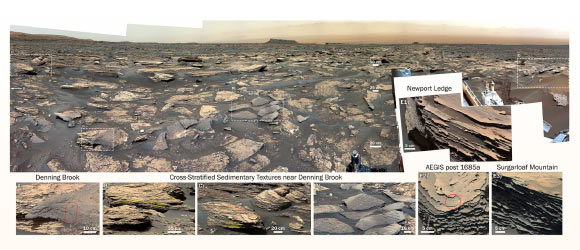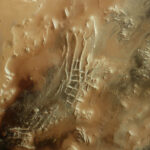In May 2017, NASA’s Curiosity rover observed higher than usual amounts of manganese in the lakebed rocks within Gale crater, Mars. These sedimentary rocks have larger grain sizes than what is typical for the lakebed rocks in the crater. This may indicate that the original sediments were formed in a river, delta, or near the shoreline in the ancient lake. In a new paper, Dr. Patrick Gasda from Los Alamos National Laboratory and his colleagues discuss how manganese could have been enriched in these rocks — for example, by percolation of groundwater through the original sediments or through the rock afterward — and what oxidant could be responsible for the precipitation of manganese in the rocks. On Earth, manganese becomes enriched because of oxygen in the atmosphere and this process is often sped up by the presence of microbes. Microbes on Earth can use the many oxidation states of manganese as energy for metabolism; if life was present on ancient Mars, the increased amounts of manganese in these rocks along the lake shore would be a helpful energy source for life.
Mastcam mosaic from the Sol 1686 rover location looking behind the rover (downslope) at the transition point between the Sutton Island and Blunts Point Murray members. Images from Sols 1685-1689 display sedimentary textures of dark-toned manganese-rich sandstones and nearby rocks. Dashed line boxes in the large mosaic are shown as insets along the bottom of figure. Small red outlines show the approximate locations and extent of ChemCam observations. Throughout this transition area, dark-toned sandstones (presumably manganese-rich based on ChemCam observations at three locations) overlie light-toned materials. Insets from left to right: (a) Denning Brook, a manganese-rich fine-grained dark-toned sandstone ChemCam observation; (b) and (c) two light-toned blocks with cross-stratified textures, highlighted with yellow lines, 6 m away from Denning Brook and to the upper left in the large mosaic; (d) dark-toned materials (center of mosaic); and (E1) Newport Ledge, (E2) AEGIS post 1685a, (E3) Sugarloaf Mountain, three thin planar laminated dark-toned sandstones. Image credit: NASA / Caltech-JPL / MSSS.
“It is difficult for manganese oxide to form on the surface of Mars, so we didn’t expect to find it in such high concentrations in a shoreline deposit,” Dr. Gasda said.
“On Earth, these types of deposits happen all the time because of the high oxygen in our atmosphere produced by photosynthetic life, and from microbes that help catalyze those manganese oxidation reactions.”
“On Mars, we don’t have evidence for life, and the mechanism to produce oxygen in Mars’ ancient atmosphere is unclear, so how the manganese oxide was formed and concentrated here is really puzzling.”
“These findings point to larger processes occurring in the Martian atmosphere or surface water and shows that more work needs to be done to understand oxidation on Mars.”
To measure manganese abundances in lakebed rocks within Gale crater, Dr. Gasda and co-authors used the ChemCam instrument onboard NASA’s Curiosity rover.
“ChemCam is an atomic emission spectroscopy instrument that uses laser-induced breakdown spectroscopy (LIBS) to quantify elemental abundances present in a target,” they explained.
“The ChemCam LIBS uses a pulsed laser emitting a 1,067 nm beam that is focused onto a target up to 7 m from the rover, which produces an analytical footprint of 350-550 μm.”
“Each laser pulse ablates and ionizes a small (nanograms to micrograms) amount of material.”
“Light emitted from the plasma formed by each laser pulse is collected by the ChemCam telescope, and spectra are recorded by the ultraviolet, violet, and visible to near infrared spectrometers.”
The sedimentary rocks explored by the Curiosity rover are a mix of sands, silts, and muds.
The sandy rocks are more porous, and groundwater can more easily pass through sands compared to the muds that make up most of the lakebed rocks in Gale crater.
The researchers looked at how manganese could have been enriched in these sands — for example, by percolation of groundwater through the sands on the shore of a lake or mouth of a delta — and what oxidant could be responsible for the precipitation of manganese in the rocks.
On Earth, manganese becomes enriched because of oxygen in the atmosphere, and this process is often sped up by the presence of microbes.
Microbes on Earth can use the many oxidation states of manganese as energy for metabolism; if life was present on ancient Mars, the increased amounts of manganese in these rocks along the lake shore would have been a helpful energy source for life.
“The Gale lake environment, as revealed by these ancient rocks, gives us a window into a habitable environment that looks surprisingly similar to places on Earth today,” said ChemCam principal investigator Dr. Nina Lanza, a researcher at Los Alamos National Laboratory.
“Manganese minerals are common in the shallow, oxic waters found on lake shores on Earth, and it’s remarkable to find such recognizable features on ancient Mars.”
The team’s paper was published in the Journal of Geophysical Research: Planets.
_____
P.J. Gasda et al. 2024. Manganese-Rich Sandstones as an Indicator of Ancient Oxic Lake Water Conditions in Gale Crater, Mars. JGR: Planets 129 (5): e2023JE007923; doi: 10.1029/2023JE007923




